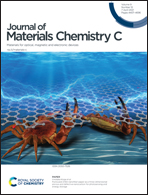Magnetic field coupling microfluidic synthesis of diluted magnetic semiconductor quantum dots: the case of Co doping ZnSe quantum dots†
Abstract
A magnetic field coupling microfluidic process was developed to synthesize diluted magnetic semiconductors (DMSs) using Co-doped ZnSe quantum dots (QDs). Field effects on their sizes, shapes, and magnetic and optical properties were investigated using magnetic fields of 0 mT, 50 mT, and 100 mT. The fields had no distinct effects on the flower-like morphology and composition of the DMS aggregates formed by several small QDs but increased the sizes and doping amount of QDs, which affected their magnetic and optical properties. The hysteresis loops showed that the saturation magnetization and coercive force of the samples synthesized under the applied field were lower than those of the samples synthesized without applied fields. A critical comparison of the zero-field-cooled and field-cooled (ZFC–FC) curves further denoted that the ferromagnetism decreased under applied fields. By calculating the band gap via UV-vis absorbance, we found that compared with ZnSe QDs, the band gap of ZnCoSe QDs narrowed as the field increased. The photoluminescence emissions of the ZnCoSe QDs were also confirmed to show distinct red shifts as the field increased. Thus, controlling the applied magnetic field affected the amount of Co doping, particle size, and band gap to realize the online control of the QDs' magnetic and optical properties.



 Please wait while we load your content...
Please wait while we load your content...